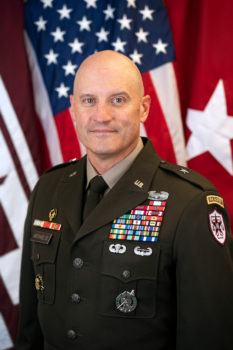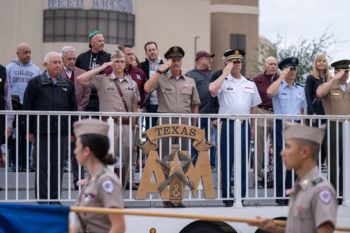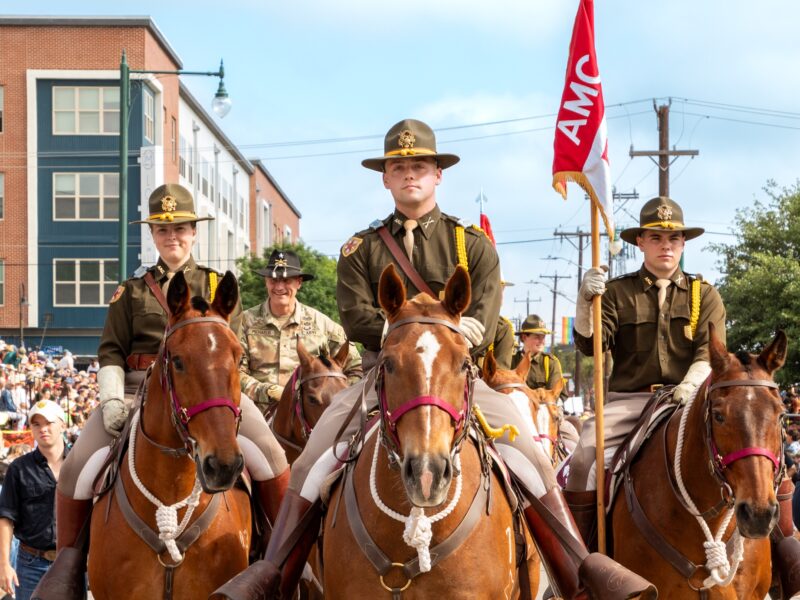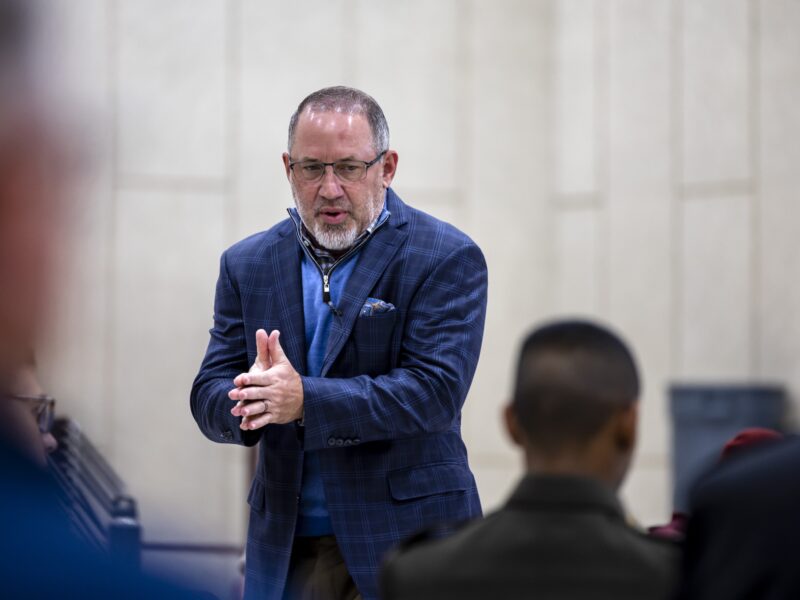Q&A With The New Commandant Of Texas A&M’s Corps Of Cadets

As the son of an Army officer and the grandson of an Army Air Corpsman, Brig. Gen. Patrick R. Michaelis likes to say it was only natural that he, too, would join the service. But it was the son of a neighbor while Michaelis was a high school senior living in the Panama Canal Zone who put him on the path toward attending Texas A&M University.
The son of another Army officer who lived across the street came home during Spring Break one year, Michaelis remembers. The rising senior was a member of Texas A&M’s Corps of Cadets, which is the largest uniformed student body in the nation outside of the military academies.
“He had these boots, and he carried himself in this incredible way,” Michaelis said. “We engaged in a conversation about his experience, and I said, ‘I want to be a part of that.’”
Michaelis would go on to earn a bachelor’s degree from Texas A&M in 1993 and commission into the Army as a second lieutenant of armor. After a distinguished military career, most recently serving as commanding general at the U.S. Army Training Center & Fort Jackson, South Carolina, Michaelis is back at Texas A&M – this time as the leader of the Corps. He started his new role as commandant on Oct. 1.
Michaelis spoke with Texas A&M Today about how his time as a cadet shaped his career, how he’s setting goals as he adjusts to the role, and the observations he’s made so far.
You’ve officially been in your new role for a little over a month. Tell us what you’ve been doing, especially regarding how you are going about assessing the Corps.
In every meeting I go to and every interaction I have, I learn something new, which is fascinating. I’ve been doing a lot of listening and asking questions.
For leaders at my level, if you’re going to learn, you have to understand what the right question is. There are a series of questions that I have out there that are really focused on, ‘Defining an impactful Corps experience. What does it mean?’ Questions that have to do with President Banks’ priority to grow the Corps to 3,000. What does that mean from a branding and marketing, recruiting, retention and financial perspective?
I also have questions about things that were not here when I was a cadet that are having a huge positive effect, like the fact that the Corps has a 3.2 grade point average – higher than the rest of the university. How do I continue to foster and amplify the great work of my predecessor, and now VP for Student Affairs, BG Joe E. Ramirez Jr.?
The moment I was announced as the commandant, I got all sorts of cards and letters, and messages from people on email, Facebook, Twitter, LinkedIn and telephone calls. It told me that a lot of people love the Corps and what it represents. Because of this, I’ve created a listening tour which will give a venue by which all those people who have an interest in the Corps can tell me their perspectives and ideas. This will then help me as we create a path forward.
Have there been any observations so far that have surprised you?
I don’t think it’s a surprise, but I’ve had confirmation of how great the students are here – how informed they are, how passionate they are, how dedicated they are to the values the Corps espouses. I said when I was announced that I want to be a presence on the Quad. I just love hanging around here and listening and learning about every single student and realizing how much potential they have to change the world.
How has the Corps changed since your time as a student in the early 1990s?
It’s not ‘old’ Army, it’s ‘their’ Army. The experiences of the Corps today are just as challenging as they were 30 years ago, yet they are also a reflection of society today. I once had a mentor who told me that traditions that remain the same are nothing more than museum pieces. We can’t be a living museum if we are going to create tomorrow’s potential today.
Compared to the experience I had 30 years ago, the output is even better today than it was back then. Companies are looking for the kind of experience that students get in the Corps: work ethic, values and intellect – that’s the secret sauce. The stats for job placement upon graduation of cadets vs the rest of the campus is pretty telling.
What do you tell high school students contemplating coming to Texas A&M and joining the Corps of Cadets?
I’d say that you will grow to be the best version of yourself in the Corps. A combination of academic excellence, a leadership laboratory applied every day, and the creation of friendships that will last a lifetime. If you want the pathway to leadership in all sectors – industry, the military, public service, non-profits – then come see what we have to offer. I briefly mentioned relationships. Let me expand a bit here. The relationships formed during your experience in the Corps will last a lifetime. Even today, 34 years after I joined the Corps, my best friends in the world are the ones I first met the day I arrived on the Quad.

Texas A&M President M. Katherine Banks has said the Corps of Cadets is at an important inflection point, and earlier this year the university announced the “March to 3,000” campaign. What do you see as your role in this effort, and how do you feel about stepping in as commandant during this time?
It’s very clear guidance of where we want the Corps to be. When I think about the March to 3,000, I think about what we’re doing when it comes to the Corps experience, what we’re doing in creating awareness of the value proposition of the Corps to students who are going through high school today. Are we structured the right way? Do we have the right facilities? Do we have the right human capital? There’s a whole suite of questions on my mind when it comes to putting into play a campaign plan that gets us to a sustainable 3,000, which is a little different than hitting the number once. You want to have a consistent 3,000 year-over-year to make sure you’ve got the organization right.
I’m excited about it. I do big ideas, and this is a big idea. We can do this. And we’ve got an incredible alignment of interest in leadership. We’re going to do this in the right way, in an aggressive way, and we’re going to produce that many more leaders for the state and nation – in all sectors.
How is the Corps building good leaders?
I think that folks who come through the Corps start to recognize the impact they have on the world around them through these leadership experiences we give them. It’s a big leadership lab and there is room to grow here. You become a better version of yourself when you leave here and you go into the service, go into business and industry, go into public service. You realize your true potential, and the Corps is going to draw it out of you.
In addition to growing the Corps, what other priorities have you identified so far?
I’m committed to three things that give the Corps anchor points to the way I think about things. Number one, I’m fully committed to academics and education. That is why we’re here. The second is, I’m committed to what I call ‘the Corps experience’ – recognizing that our model of leader development is based on a military cultural experience. The third thing I’m committed to is that this is a student-led organization. It’s an important point to recognize that if this is going to be a leadership laboratory, where we grow leaders for the state and nation using a military-based model, that we have to create an environment where students are in positions of authority, have responsibility, can make decisions and be able to try new things.
You’ve held several command roles during your military career. What is your leadership philosophy and the perspective you’re bringing to this role?
There are three things I think about when it comes to competency for tomorrow’s world. One of them is that you are an expert in your craft, and you understand the environment. This is where your education process comes into play. The second is that you have to live the values of the organization. Maybe more important is that those values must be part of your core. The third component is understanding the art and science of leadership itself. A lot of people understand the definition, but don’t necessarily understand the mechanics of how to lead in complex or uncertain environments. My leadership philosophy is really focused around those three components.
How did your time as a cadet shape who you are today?
I am the person I am today because of the experience that I had in the Corps. Many of the lessons and values I learned here carried me through my military career. We have experiences in life that help us define who we are – become part of the bedrock of who you are – and this was one of mine. When you come through the Corps at Texas A&M, these values become part of your core identity. That emanates from every decision you make, and that’s a wonderful thing.
Media contact: Amy Thompson, Corps of Cadets Marketing & Communications, amy.thompson@tamu.edu





